An introduction to using SWOT when developing strategy
There can be considered to be three key phases when developing a Strategy. The first is (i) strategic analysis, followed by (ii) strategic decision making and then (iii) developing a strategic plan and putting it into action. There are a variety of tools to use throughout this strategic process. To learn more about the tools to use and to understand how these interact, visit Strategy in Simple Steps. A SWOT analysis is one of the most commonly known tools, but should you use it?
Bite Size ‘Simple Steps’ (TLDR) – 4 Steps to Implementing a SWOT Analysis for a SaaS Startup
- Define Your Strategic Objective
- Explanation: Start by clearly defining the strategic objective you want to achieve. This could be improving customer retention, expanding into new markets, or launching a new feature. The objective will guide your SWOT analysis, ensuring it is aligned with your business goals.
- Example: A SaaS startup specializing in project management tools wants to increase market share by targeting remote work teams. The objective is to identify the strengths and weaknesses of their platform and explore opportunities in the remote work sector.
2. Assess Internal Strengths and Weaknesses
- Explanation: Evaluate the internal aspects of your business that impact your strategic objective. Identify your product’s strengths and weaknesses, such as its features, user experience, pricing, and customer support. Consider how well your team is equipped to meet the objective.
- Example: The startup’s strengths might include a user-friendly interface and strong customer support, while weaknesses could be a limited number of integrations with other tools and a small marketing budget.
3. Analyse External Opportunities and Threats
- Explanation: Examine the external environment to identify opportunities and threats that could influence your strategy. This includes market trends, competition, technological advancements, and regulatory changes.
- Example: Opportunities might include the growing trend of remote work and the increasing demand for collaboration tools. Threats could be the entry of a well-funded competitor or changing data privacy regulations that affect SaaS businesses.
4. Prioritize and Strategise
- Explanation: After listing your strengths, weaknesses, opportunities, and threats, prioritise them based on their impact and relevance to your strategic objective. Use this prioritisation to inform your decision-making and develop a strategic plan.
- Example: The startup may decide to focus on leveraging its user-friendly interface (strength) to quickly capture a share of the remote work market (opportunity), while simultaneously addressing the weakness of limited integrations by developing new partnerships.
What is a SWOT analysis?
A SWOT analysis is a tool used to identify strengths, weaknesses, opportunities, and threats. It can be applied to a situation or to oneself. It is often presented in a matrix of four boxes as illustrated below:
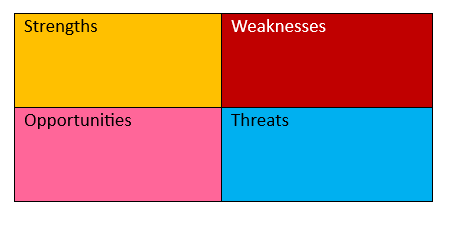
You simply list what you identify as a strength, weakness, opportunity, or threat under the relevant heading.
It sounds simple and easy to use yet in reality, people often find a lack of clarity of what to write where. It can be easy to differentiate a strength and a weakness, or an opportunity from a threat. However, can you separate a strength from an opportunity, or a weakness from a threat?
And what if something has strengths and weaknesses, or poses both opportunities and threats? The reality is that it can be easy to be lost between the four options and if you are not careful it can muddle your thinking. There are alternatives for analysing the external environment and identify opportunities and threats, such as PESTEL which you can read about in one of our other blogs. For analysing the internal environment, there are also other tools to use, and you can identify strengths and weaknesses, and rate the strategic relevance of each.
If you do apply a SWOT to yourself or to a situation, make it specific to what you want to do and follow the principle of identifying your strengths and weaknesses. Then analyse the opportunities and threats available to you. In the simplest form you could list your strengths and weaknesses.
For example, if your aim was to be involved in project work or to lead a project, your SWOT may look something like this:
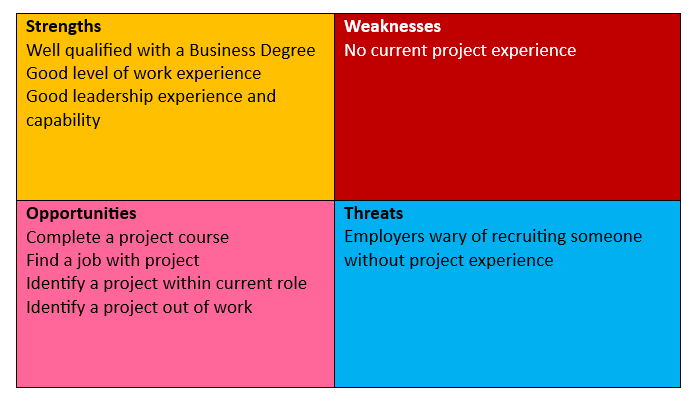
If you are using SWOT to set up a new business cleaning windows your SWOT analysis may look something like this:
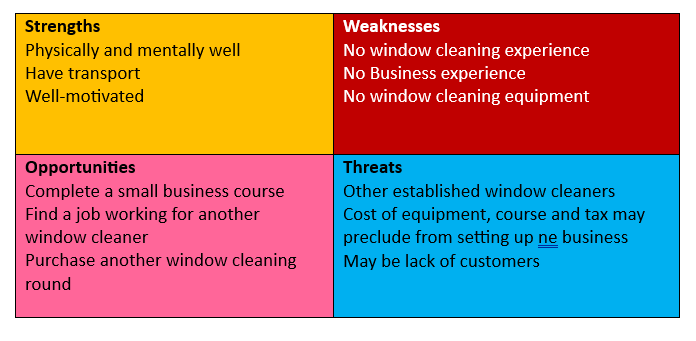
If I do use SWOT in strategic analysis, what should I do?
If you are going to use SWOT in strategic analysis, make sure you apply other relevant principles. The first step before anything else is to identify your purpose and vision. This provides the background or context for what you are analysing. Your strengths and weaknesses will be very different if you are looking at project work versus financial management for example, or if you analyse your ability at swimming or running.
Next apply strengths and weaknesses to analysis of your internal environment. Your internal environment may be yourself, your team, or organisation. Remember to link everything back to your initial purpose and list different attributes in the relevant box on the matrix.
Now apply opportunities and threats in the environment external to you, your team or organisation. Your external environment can be considered anything outside your internal environment. If you are analysing your own skills, you are the internal environment and your team and organisation, and wider world are the external environment. If you are analysing your team, the external environment includes everything beyond that. Read more on this in Strategy in Simple Steps.
You can add internal and external analysis to the SWOT table to prompt you as illustrated below:
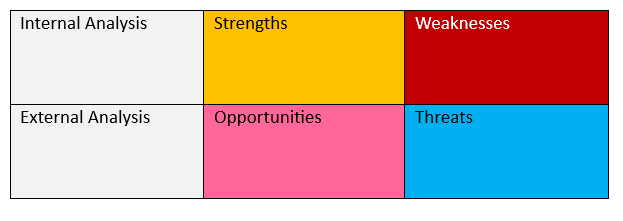
Okay, I want to take this a step further….
To improve your analysis, you can apply sub-headings to your internal and external analysis as illustrated below:
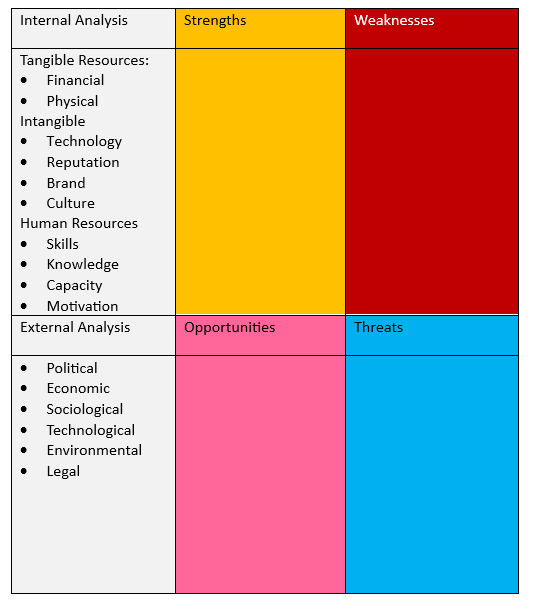
The benefit of this is to provide headings to prompt thoughts and to structure your analysis.
The downside to using the SWOT tool is that it is binary in that it encourages you to identify something as either a strength or weakness, or as an opportunity or threat. This can simplify thinking but in reality, internal aspects can be both a strength and a weakness, and external aspects can be both an opportunity and a threat. Depending on what you are looking at, a better analysis could be to use the headings for internal and external analysis and attribute strength (S) and/or weakness (W) to the internal analysis, and opportunities (O) and/or threat (T) to the external analysis. However, this is not a SWOT analysis, and becomes something different.
Conclusion
SWOT is a tool to analyse a situation or oneself. It is well known and can be quick and easy to use. There is a risk of not using the tool to its full potential if you ‘just do a SWOT analysis’. THE SWOT tool can be enhanced by ensuring that strengths and weaknesses analysis is made of internal aspects, whether of oneself, a team or organisation. Also, ensure that opportunities and threats analysis is applied to external aspects. Be aware of other tools for each phase of developing a strategy and how they interact. Find out more by reading Strategy in Simple Steps.





